

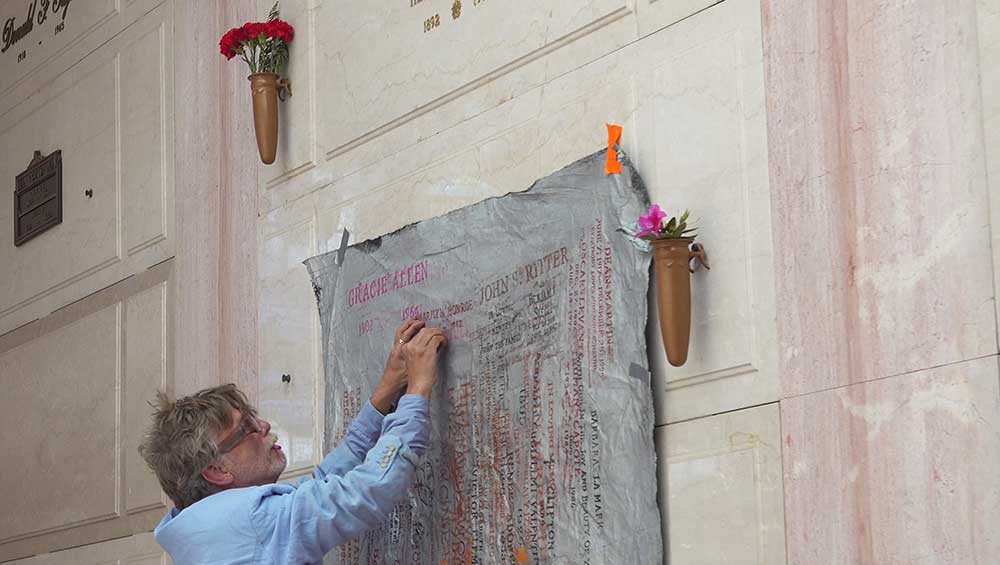
Scott Covert, Up Until Now (still), c1990–2022. Video (colour, sound), 22 min 21 sec. Filming by Lex Niarchos, editing by Jin Lee.
by ANGERIA RIGAMONTI di CUTÒ
For nearly four decades Scott Covert (b1954 New Jersey) has been stealthily trawling the cemeteries of north America and Europe, tracing the epitaphs of the (mostly) famous to create intricate assemblages combining elements of pop glamour, land art, printmaking, painterly abstraction and text-based conceptual art.
Popular in the Victorian era, a notable mid-20th century practitioner of gravestone frottage that incorporated other techniques was the Hungarian-born American artist Sari Dienes, a pioneer of assemblage and an influence on two of her studio assistants, Jasper Johns and Robert Rauschenberg. Covert began his artistic trajectory as a performer, with a few incursions into an institutional study of art, concocting his sui generis practice within the grimy, outsiderish allure of the late 70s/early 80s East Village arts scene – an ambiance recently explored in the documentary Make Me Famous.
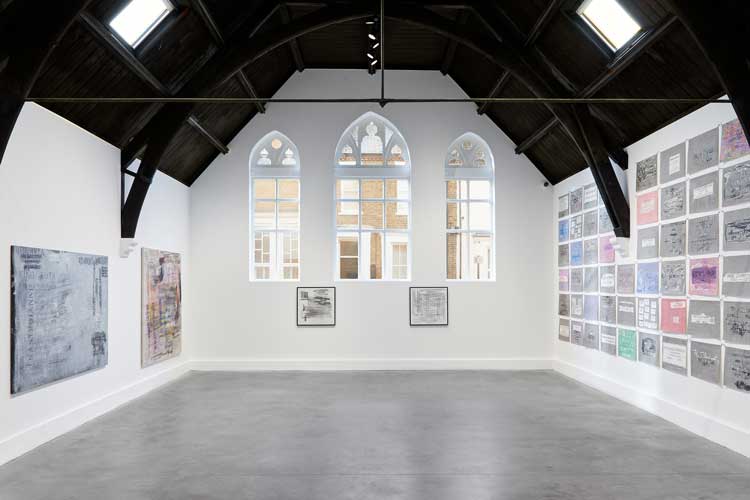
Scott Covert, Cest la vie, installation view, Studio Voltaire, 2023. Image courtesy of the artist and Studio Voltaire, Photo: Sarah Rainer.
On view at the aptly Victorian gothic space of Studio Voltaire are a few large-scale canvases and more than 100 smaller works on paper, cleverly arranged in orderly, floor-to-ceiling rows that recall the vertically stacked graves of many cemeteries. Some of Covert’s palimpsests record a single person, but the most remarkable are elaborate accretions of different names, colours and fonts, densely stratified characters in the typographical as well as figurative sense. Those with multiple protagonists form spectral networks that are by turns jarring, pleasingly intuitive and, at times, tragi-comic.
Angeria Rigamonti di Cutò: You had theatrical beginnings before turning to art, acting for various companies and co-founding Playhouse 57 at Club 57, which seems like the essence of a collective, familial way of working, with all the pros and cons that that entails. Was the transition to a much more solitary way of working part of the appeal of the direction you later took?
Scott Covert: When I first moved to New York, I was doing repertory theatre. Andy Rees and I started Playhouse 57 in the basement of a deconsecrated church on St Mark’s Place, and the collaboration was a group of kids having fun. Every night was a different performance. Scott Wittman and Marc Shaiman – who later wrote Hairspray and have Some Like It Hot on Broadway right now – came in and started doing musicals. We did Boing Boing as dinner theatre and served macaroni and cheese. It was supposed to be Boeing Boeing but we didn’t pay residuals … I played the Jerry Lewis character. We did Living Dolls, a musical about Barbie and Ken – I was Poindexter Mattel, the heir to the Mattel family. I would be Rhoda in The Bad Seed as my drag persona Becky Rockefeller. And then I would do Scott and Marc’s The Trojan Women in Vegas, in the burnt-out rooms of the MGM Grand. It was four nights of different theatre every week. And after I did that, I absolutely hated it! Before I was an actor, I was making art, and I was very happy to get on my own and get away from the group. I like to work by myself.
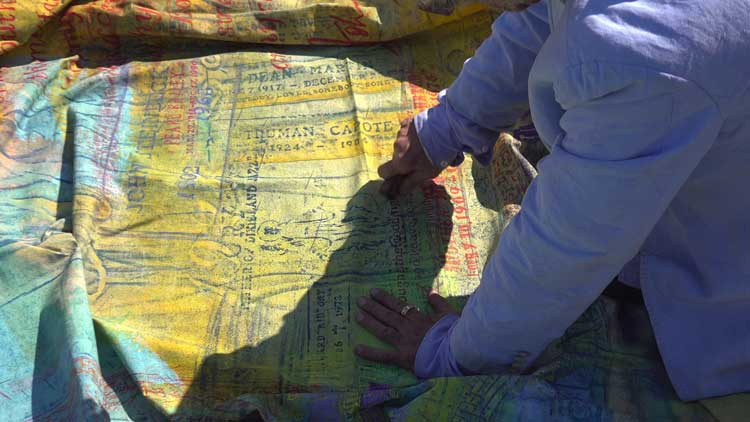
Scott Covert, Up Until Now (still), c1990–2022. Video (colour, sound), 22 min 21 sec. Filming by Lex Niarchos, editing by Jin Lee.
ARC: Do you think that live performing gave you anything that served you as an artist, or was it simply a stage you had to go through, something to get out of your system before finding your true calling?
SC: That’s exactly what it was. I would always have regretted not trying to act. I had incredible headshots taken, and when I got them, I said: “No, I'm not doing this any more.” And I would have got work with those headshots! But I had lived it, been there, done that. Get me out of here.
ARC: The 2018 MoMA exhibition on Club 57 showed one of your early decorated skulls. What compelled you to work with human remains? It’s probably inevitable that onlookers would make the association between your attention to deathly subjects and the devastation of the Aids epidemic, though you have said you didn’t feel they were connected.
SC: I really don’t feel they are connected, but everybody else feels they are. And maybe they were: I was watching all my friends die. However, the skulls were earlier, around 1979, so the subject interested me before. I painted skulls because I thought it would be very chic.
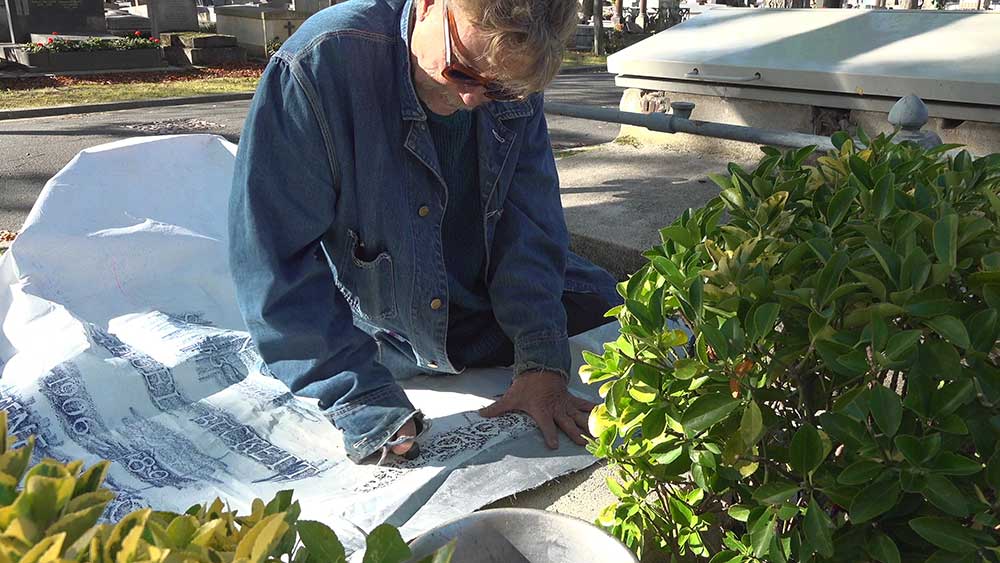
Scott Covert, Up Until Now (still), c1990–2022. Video (colour, sound), 22 min 21 sec. Filming by Lex Niarchos, editing by Jin Lee.
ARC: You then began your practice of making impressions of graves. You’ve said that Cookie Mueller immediately saw something special about these and strongly encouraged you to pursue this direction. You went to a cemetery to make rubbings as a class activity in school, but what stirred you years later to return to this Victorian tradition?
SC: Cookie’s reviews of my early works (in Saturday Review and Details magazine) were reprinted in a South African magazine, and in 1985 I was offered a show in Cape Town. It was during apartheid, so of course I couldn’t do that, but it did prompt me to think about how I might critically confront that context and pay tribute to African American people I admired. People such as Florence Ballard, who was the first person I made a headstone relief of.
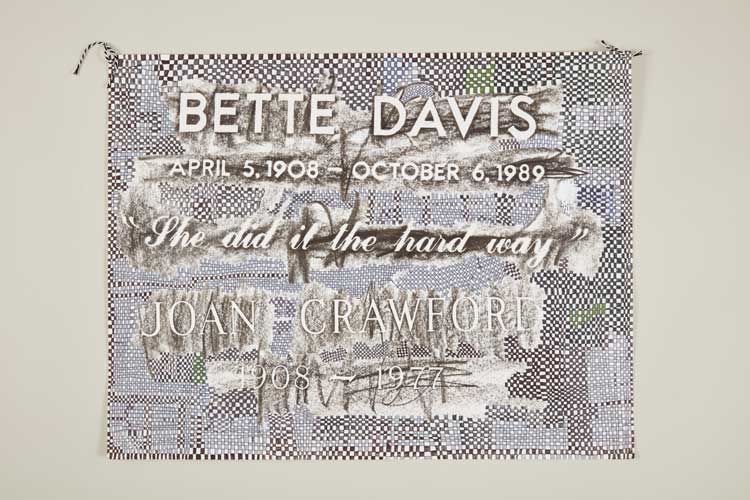
Scott Covert, Lifetime Drawing,
Bette Davis and Joan Crawford,
undated. Courtesy of the artist.
When I was growing up, everybody asked, are you for the Beatles or the Rolling Stones? It was “She loves you, yeah, yeah, yeah” or “I can’t get no satisfaction”. But I wanted neither of them: give me the Supremes. The first song I saw them sing on The Ed Sullivan Show was When the Lovelight Starts Shining Through His Eyes. They were wearing all those sequins, and it was just so beautiful to me. Florence had such a tragic story; she was the belter, she could sing. But Diana Ross had that pretty voice and, I mean, I still freak out about her. The Supremes were the first concert I saw as a child, at the Garden State Arts Center in New Jersey. I just saw Diana live again at Radio City Music Hall, and it was incredible. As old as I am and as old as she is.
ARC: Your works are easily incorporated into the technique of frottage, which in the surrealist context was seen as an “automatic” type of art. But they’re so intricate and entail so many decisions and processes – in the choice of different washes, painterly brushwork, painstaking layouts of fonts and colour fields, repetitions, etc – that they seem anything but automatic, beyond the fact that you use existing epitaphs as one component. What is that process like? Do you start mapping the works out at the time of taking the impressions or do you work out the design later within in a more conventional studio-like setting?
SC: I always work on site; I create a printing press in the middle of the cemetery. It’s totally intuitive when I’m there. Where does this go? What does that do? I select which paintings I want to travel with in advance, works I feel are not finished. Sometimes, if I’ve not been before, I need to know what the gravestone looks like before I make any decisions. Others, such as Houdini, are familiar to me, and I know exactly what his effect will be on the canvas. For me, each brushstroke is a lifetime.
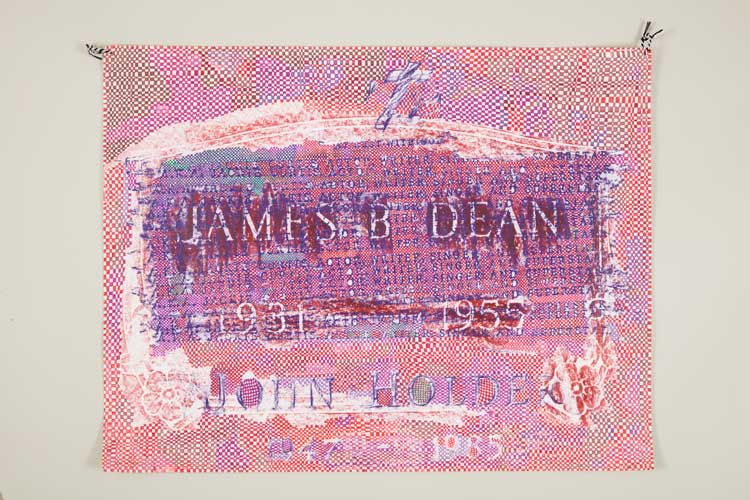
Scott Covert, Lifetime Drawing,
James Dean, Red, undated. Courtesy of the artist.
ARC: Another sense in which they seem quite complex is the way you contrast different people within the same work, whether couples or larger constellations of deceased subjects. What lies behind your choices of which names to place on the same canvas and how premeditated – or intuitive – are those decisions?
SC: I want you to look at a canvas like it is an aquarium. The premeditated part that I want to make clear, through the people I depict, is that a painting has been to Moscow, Los Angeles, Bonn, Mexico City, Paris. I’m making an abstract painting with pop figures. The two most important schools in 20th-century American art history are pop and abstract expressionism and I combine them in my work. I’ve heard I’m the first person to do it successfully!
ARC: A significant aspect of these works is also what comes before the physical artefact: the journeys to the various sites, the travelling, driving, negotiating the different cemeteries and their custodians, which presumably can’t all be plain sailing. Have you documented this aspect of your work, whether in writing, photography or film? Your peregrinations would lend themselves very well to some sort of cinematic treatment.
SC: My friend Lex has been travelling alongside me, and we film my process of making the work, even just the long drives down the highway. There is a 20-minute segment of this documentation in C’est La Vie at Studio Voltaire, which includes the most recent footage, as well as very early videotapes from the 1990s, taken at Brian Jones’ grave in Cheltenham. Eventually, I would like it to be an eight-channel video installation, with eight hours on each screen. You wouldn’t have to watch the whole thing, but I would like it to embody my work’s journey all around the world … and Lex has his own ideas that I listen to.
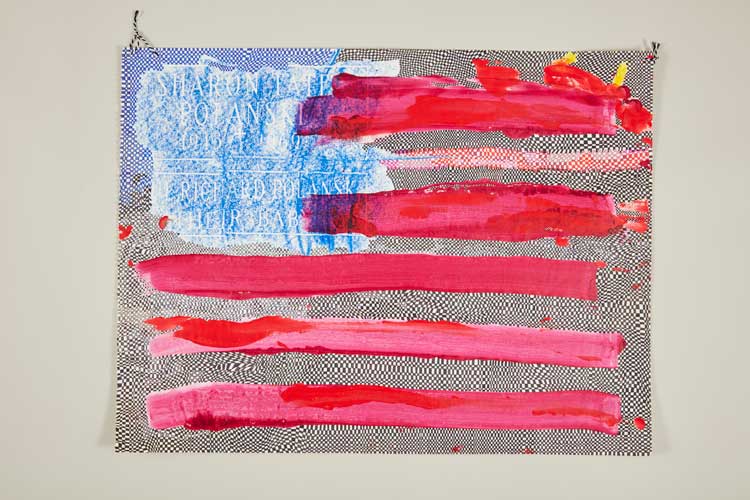
Scott Covert, Lifetime Drawing,
Sharon Tate and Richard
Polanski, undated. Courtesy of the artist.
ARC: Have you ever been moved to transcribe the epitaph of an unknown person, or is your subjects’ fame a fundamental aspect of the work? And are there any well-known subjects you wouldn’t use on moral grounds – though you have used Versace’s killer?
SC: I have morals, but if a person has a gravestone, yes, I could do it. I have assembled rows of epitaphs taken from anyone to create poems; or I’ll always do an Alice Cooper when I see one. I introduced two people unknown to me – Drusilla and Druzilla – in the exhibition. I found Druzilla first, and months later in another cemetery, in another part of the US, I saw Drusilla. So, I recorded her, thinking I could introduce her to Druzilla. It took over a year to make that piece, so I do work with my “unknowns”.
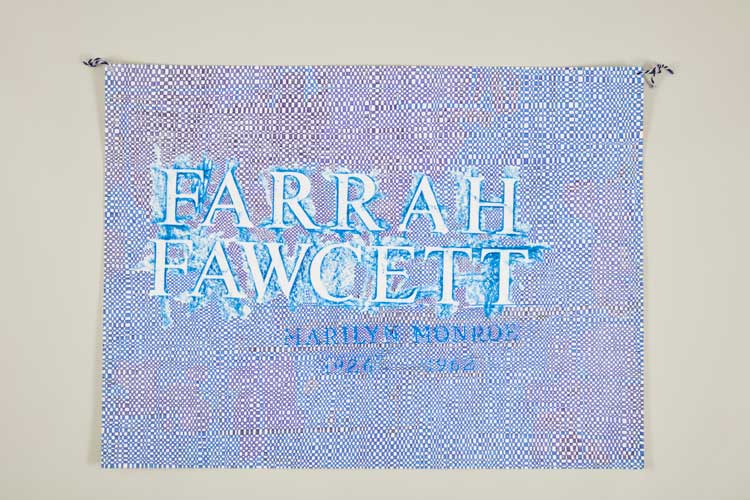
Scott Covert, Lifetime Drawing,
Farrah Fawcett, Blue, undated. Courtesy of the artist.
ARC: Since we’re in London, whose headstones have you transcribed in this city’s graveyards? And have your visits to so many cemeteries in different countries given you a sense of national variations in attitudes to death?
SC: I've been to London before and visited Highgate cemetery. I made a rubbing of Karl Marx’s headstone: I put him with Groucho Marx. I had a whole sheet with Groucho recorded in different colours, and I placed Karl right on top. This past week, I went to Amy Winehouse’s grave, and to William Blake’s. It’s a little cold at the moment: the canvases and the oil wax pastels I use for the rubbings become brittle and difficult to work with in the cold.
ARC: How have your decades of trawling through so many cemeteries affected your own feelings about the idea of mortality? Have they nurtured a more carpe diem approach or offered any protection against fear of dying?
SC: I have no fear of dying, especially now. What concerns me is that I have so much work still to finish! I just don’t want to leave behind a whole bunch of unfinished paintings. I’m still trying to make each one beautiful, and I think they get better the more I add on to them. I try to live in the moment all the time.
• Scott Covert: C’est La Vie is at Studio Voltaire, London until 23 April 2023.